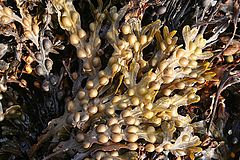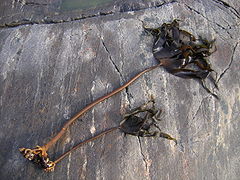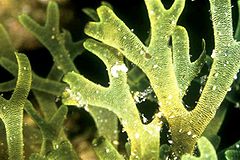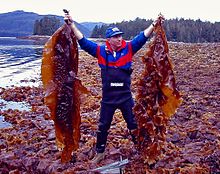- Brown algae
-
Brown algae
Temporal range: 150–0 Ma[1][2]
Giant kelp (Macrocystis pyrifera) Scientific classification Domain: Eukaryota Kingdom: Chromalveolata Division: Heterokontophyta Class: Phaeophyceae
Kjellman, 1891[3]Orders see Classification.
Synonyms Fucophyceae
Melanophyceae
PhaeophytaThe Phaeophyceae or brown algae (singular: alga), is a large group of mostly marine multicellular algae, including many seaweeds of colder Northern Hemisphere waters. They play an important role in marine environments, both as food and for the habitats they form. For instance Macrocystis, a kelp of the order Laminariales, may reach 60 m in length, and forms prominent underwater forests. Another example is Sargassum, which creates unique habitats in the tropical waters of the Sargasso Sea. Many brown algae, such as members of the order Fucales, commonly grow along rocky seashores. Some members of the class are used as food for humans.
Worldwide there are about 1500–2000 species of brown algae.[4] Some species are of sufficient commercial importance, such as Ascophyllum nodosum, that they have become subjects of extensive research in their own right.[5]
Brown algae belong to a very large group, the Heterokontophyta, a eukaryotic group of organisms distinguished most prominently by having chloroplasts surrounded by four membranes, suggesting an origin from a symbiotic relationship between a basal eukaryote and another eukaryotic organism. Most brown algae contain the pigment fucoxanthin, which is responsible for the distinctive greenish-brown color that gives them their name. Brown algae are unique among heterokonts in developing into multicellular forms with differentiated tissues, but they reproduce by means of flagellated spores and gametes that closely resemble cells of other heterokonts. Genetic studies show their closest relatives to be the yellow-green algae.
Contents
Morphology
Brown algae exist in a wide range of sizes and forms. The smallest members of the group grow as tiny, feathery tufts of threadlike cells no more than a few centimeters long.[6] Some species even have a stage in their life cycle that consists of only a few cells, making the entire alga microscopic. Other groups of brown algae grow to much larger sizes. The rockweeds and leathery kelps are often the most conspicuous algae in their habitats.[7] Kelps can range in size from the two-foot-tall sea palm Postelsia to the giant kelp Macrocystis pyrifera, which grows to over 45 m (150 ft) long[8][9] and is the largest of all the algae. In form, the brown algae range from small crusts or cushions[10] to leafy free-floating mats formed by species of Sargassum. They may consist of delicate felt-like strands of cells, as in Ectocarpus, or of foot-long flattened branches resembling a fan, as in Padina.
Reagrdless of size or form, two visible features set the Phaeophyceae apart from all other algae. First, members of the group possess a characteristic color that ranges from an olive green to various shades of brown. The particular shade depends upon the amount of fucoxanthin present in the alga.[11] Second, all brown algae are multicellular. There are no known species that exist as single cells or as colonies of cells,[11] and the brown algae are the only major group of seaweeds that does not include such forms. However, this may be the result of classification rather than a consequence of evolution, as all the groups hypothesized to be the closest relatives of the browns include single-celled or colonial forms.
Visible structures
Whatever their form, the body of all brown algae is termed a thallus, indicating that it lacks the complex xylem and phloem of vascular plants. This does not mean that brown algae completely lack specialized structures. But, because some botanists define "true" stems, leaves, and roots by the presence of these tissues, their absence in the brown algae means that the stem-like and leaf-like structures found in some groups of brown algae must be described using different terminology.[12] Although not all brown algae are structurally complex, those that are typically possess one or more characteristic parts.
A holdfast is a rootlike structure present at the base of the alga. Like a root system in plants, a holdfast serves to anchor the alga in place on the substrate where it grows, and thus prevents the alga from being carried away by the current. Unlike a root system, the holdfast generally does not serve as the primary organ for water uptake, nor does it take in nutrients from the substrate. The overall physical appearance of the holdfast differs among various brown algae and among various substrates. It may be heavily branched, or it may be cup-like in appearance. A single alga typically has just one holdfast, although some species have more than one stipe growing from their holdfast.
A stipe is a stalk or stemlike structure present in an alga. It may grow as a short structure near the base of the alga (as in Laminaria), or it may develop into a large, complex structure running throughout the algal body (as in Sargassum or Macrocystis). In the most structurally differentiated brown algae (such as Fucus), the tissues within the stipe are divided into three distinct layers or regions. These regions include a central pith, a surrounding cortex, and an outer epidermis, each of which has an analog in the stem of a vascular plant. In some brown algae, the pith region includes a core of elongated cells that resemble the phloem of vascular plants both in structure and function. In others (such as Nereocystis), the center of the stipe is hollow and filled with gas that serves to keep that part of the alga buoyant. The stipe may be relatively flexible and elastic in species like Macrocystis pyrifera that grow in strong currents, or may be more rigid in species like Postelsia palmaeformis that are exposed to the atmosphere at low tide.
Many algae have a flattened portion that may resemble a leaf, and this is termed a blade, lamina, or frond. The name blade is most often applied to a single undivided structure, while frond may be applied to all or most of an algal body that is flattened, but this distinction is not universally applied. The name lamina refers to that portion of a structurally differentiated alga that is flattened. It may be a single or a divided structure, and may be spread over a substantial portion of the alga. In rockweeds, for example, the lamina is a broad wing of tissue that runs continuously along both sides of a branched midrib. The midrib and lamina together constitute almost all of a rockweed, so that the lamina is spread throughout the alga rather than existing as a localized portion of it.
 Species like Fucus vesiculosus produce numerous gas-filled pneumatocysts (air bladders) to increase buoyancy.
Species like Fucus vesiculosus produce numerous gas-filled pneumatocysts (air bladders) to increase buoyancy.
In some brown algae, there is a single lamina or blade, while in others there may be many separate blades. Even in those species that initially produce a single blade, the structure may tear with rough currents or as part of maturation to form additional blades. These blades may be attached directly to the stipe, to a holdfast with no stipe present, or there may be an air bladder between the stipe and blade. The surface of the lamina or blade may be smooth or wrinkled; its tissues may be thin and flexible or thick and leathery. In species like Egregia menziesii, this characteristic may change depending upon the turbulence of the waters in which it grows.[6] In other species, the surface of the blade is coated with slime to discourage the attachment of epiphytes or to deter herbivores. Blades are also often the parts of the alga that bear the reproductive structures.
Gas-filled floats called pneumatocysts provide buoyancy in many kelps and members of the Fucales. These bladder-like structures occur in or near the lamina, so that it is held nearer the water surface and thus receives more light for photosynthesis. Pneumatocysts are most often spherical or ellipsoidal, but can vary in shape among different species. Species such as Nereocystis luetkeana and Pelagophycus porra bear a single large pneumatocyst between the top of the stipe and the base of the blades. In contrast, the giant kelp Macrocystis pyrifera bears many blades along its stipe, with a pneumatocyst at the base of each blade where it attaches to the main stipe. Species of Sargassum also bear many blades and pneumatocysts, but both kinds of structures are attached separately to the stipe by short stalks. In species of Fucus, the pneumatocysts develop within the lamina itself, either as discrete spherical bladders or as elongated gas-filled regions that take the outline of the lamina in which they develop.
Growth
The brown algae include the largest and fastest growing of seaweeds.[6] Fronds of Macrocystis may grow as much as 50 centimetres (20 in) per day, and the stipes can grow 6 centimetres (2.4 in) in a single day.[13]
Growth in most brown algae occurs at the tips of structures as a result of divisions in a single apical cell or in a row of such cells.[7] As this apical cell divides, the new cells that it produces develop into all the tissues of the alga. Branchings and other lateral structures appear when the apical cell divides to produce two new apical cells. However, a few groups (such as Ectocarpus) grow by a diffuse, unlocalized production of new cells that can occur anywhere on the thallus.[11]
Tissue organization
The simplest browns are filamentous—that is, their cells are elongate and have septa cutting across their width. They branch by getting wider at their tip, and then dividing the widening.[14]
Aside from filamentous forms, there are two main types of tissue organization in the brown algae: pseudoparenchymatous (haplostichous) and parenchymatous (polystichous).[15] The fronds may be multiaxial or monoaxial.
The cell wall consists of two layers; the inner layer bears the strength, and consists of cellulose; the outer wall layer is mainly algin, and is gummy when wet but becomes hard and brittle when it dries out.[15]
Evolutionary history
Genetic and ultrastructural evidence place the Phaeophyceae among the heterokonts (Stramenopiles),[16] a large assemblage of organisms that includes both photosynthetic members with plastids (such as the diatoms) as well as non-photosynthetic groups (such as the slime nets and water molds). Although some heterokont relatives of the brown algae lack plastids in their cells, scientists believe this is a result of evolutionary loss of that organelle in those groups rather than independent acquisition by the several photosynthetic members.[17] Thus, all heterokonts are believed to descend from a single heterotrophic ancestor that became photosynthetic when it acquired plastids through endosymbiosis of another unicellular eukaryote.[4]
The closest relatives of the brown algae include unicellular and filamentous species, but no unicellular species of brown algae are known. However, most scientists assume that the Phaeophyceae evolved from unicellular ancestors.[18] DNA sequence comparison also suggests that the brown algae evolved from the filamentous Phaeothamniophyceae,[19] Xanthophyceae,[20] or the Chrysophyceae[21] between 150[1] and 200 million years ago.[2] In many ways, the evolution of the brown algae parallels that of the green algae and red algae,[22] as all three groups possess complex multicellular species with an alternation of generations. Analysis of 5S rRNA sequences reveals much smaller evolutionary distances among genera of the brown algae than among genera of red or green algae,[2][23] which suggests that the brown algae have diversified much more recently than the other two groups.
Fossils
The occurrence of Phaeophyceae as fossils is rare due to their generally soft-bodied nature,[24] and scientists continue to debate the identification of some finds.[25] Part of the problem with identification lies in the convergent evolution of morphologies between many brown and red algae.[26] Most fossils of soft-tissue algae preserve only a flattened outline, without the microscopic features that permit the major groups of multicellular algae to be reliably distinguished. Among the brown algae, only species of the genus Padina deposit significant quantities of minerals in or around their cell walls.[27] Other algal groups, such as the red algae and green algae, have a number of calcareous members. Because of this, they are more likely to leave evidence in the fossil record than the soft bodies of most brown algae and more often can be precisely classified.[28]
Fossils comparable in morphology to brown algae are known from strata as old as the Upper Ordovician,[29] but the taxonomic affinity of these impression fossils is far from certain.[30] Claims that earlier Ediacaran fossils are brown algae[31] have since been dismissed.[19] While many carbonaceous fossils have been described from the Precambrian, they are typically preserved as flattened outlines or fragments measuring only millimeters long.[32] Because these fossils lack features diagnostic for identification at even the highest level, they are assigned to fossil form taxa according to their shape and other gross morphological features.[33] A number of Devonian fossils termed fucoids, from their resemblance in outline to species in the genus Fucus, have proven to be inorganic rather than true fossils.[24] The Devonian megafossil Prototaxites, which consists of masses of filaments grouped into trunk-like axes, has been considered a possible brown alga.[11] However, modern research favors reinterpretation of this fossil as a terrestrial fungus or fungal-like organism.[34] Likewise, the fossil Protosalvinia was once considered a possible brown alga, but is now thought to be an early land plant.[35]
A number of Paleozoic fossils have been tentatively classified with the brown algae, although most have also been compared to known red algae species. Phascolophyllaphycus possesses numerous elongate, inflated blades attached to a stipe. It is the most abundant of algal fossils found in a collection made from Carboniferous strata in Illinois.[36] Each hollow blade bears up to eight pneumatocysts at its base, and the stipes appear to have been hollow and inflated as well. This combination of characteristics is similar to certain modern genera in the order Laminariales (kelps). Several fossils of Drydenia and a single specimen of Hungerfordia from the Upper Devonian of New York have also been compared to both brown and red algae.[26] Fossils of Drydenia consist of an elliptical blade attached to a branching filamentous holdfast, not unlike some species of Laminaria, Porphyra, or Gigartina. The single known specimen of Hungerfordia branches dichotomously into lobes and resembles genera like Chondrus and Fucus[26] or Dictyota.[37]
The earliest known fossils that can be assigned reliably to the Phaeophyceae come from Miocene diatomite deposits of the Monterey Formation in California.[4] Several soft-bodied brown macroalgae, such as Julescraneia, have been found.[38]
Classification
Further information: List of brown algal generaThis is a list of the orders in the class Phaeophyceae:[39]
- Ascoseirales Petrov
- Cutleriales Oltmanns
- Desmarestiales Setchell & Gardner
- Dictyotales Kjellman
- Discosporangiales
- Ectocarpales Setchell & Gardner
- Fucales Kylin
- Ishigeales G. Y. Cho & Boo
- Laminariales Migula
- Nemodermatales M. Parente, R. L. Fletcher, F. Rousseau & N. Phillips
- Onslowiales Draisma & Prud'homme van Reine ex Phillips et al.
- Ralfsiales Nakamura
- Scytosiphonales Feldmann
- Scytothamnales A. F. Peters & M. N. Clayton
- Sphacelariales Migula
- Sporochnales Sauvageau
- Syringodermatales E. C. Henry
- Tilopteridales Bessey
Life cycle
Sexual reproduction may be isogamous, oogamous, or anisogamous. Union of gametes may take place in water or within the oogonium (oogamous species). The life cycle shows great variability from one group to another.
However, the life cycle of Laminaria consists of the diploid generation, that is the large kelp well known to most people, producing sporangia from specialised microscopic structures, which divide meiotically before they are released. As they are haploid there are equal numbers of male and female spores.[40] With the exception of the Fucales, all brown algae have a life cycle with an alternation between haploid and diploid forms.
Ecology
Brown algae have adapted to a wide variety of marine ecological niches including the tidal splash zone, rock pools, the whole intertidal zone and relatively deep near shore waters. They are an important constituent of some brackish water ecosystems, and four species are restricted to life in fresh water.[19] A large number of Phaeophyceae are intertidal or upper littoral,[19] and they are predominantly cool and cold water organisms that benefit from nutrients in up welling cold water currents and inflows from land; Sargassum being a prominent exception to this generalisation.
Brown algae growing in brackish waters are almost solely asexual.[19]
Chemistry
Algal group δ13C range[41] HCO3-using red algae −22.5‰ – −9.6‰ CO2-using red algae −34.5‰ – −29.9‰ Brown algae −20.8‰ – −10.5‰ Green algae −20.3‰ – −8.8‰ Brown algae have a δ13C value in the range of −20.8‰ – −10.5‰, in contrast with red algae and greens. This reflects their different metabolic pathways.[42]
They have cellulose walls with alginic acid; fucoidin also important in amorphous section of cell walls. A few species (of Padina) calcify with aragonite needles.[19]
Brown algae produce a specific type of tannin called phlorotannins.
Importance and uses
The brown algae include a number of edible seaweeds.
See also
- Wrack (seaweed)
References
- ^ a b Medlin, L. K.; Kooistra, W. H. F.; Potter, D.; Saunders, G. W.; Andersen, R. A. (1997). "Phylogenetic relationships of the 'golden algae' (haptophytes, heterokont chromophytes) and their plastids" (PDF). Origins of algae and their plastids: 187–219. http://epic.awi.de/Publications/Med1997c.pdf.
- ^ a b c Lim, B.-L.; Kawai, H.; Hori, H.; Osawa, S. (1986). "Molecular evolution of 5S ribosomal RNA from red and brown algae". Idengaku Zasshi (Japanese Journal of Genetics) 61 (2): 169–176.
- ^ Kjellman, F. R. (1891). "Phaeophyceae (Fucoideae)". In Engler, A. & Prantl, K. (eds.). Die natürlichen Pflanzenfamilien. 1 (2). Leipzig: Wilhelm Engelmann. pp. 176–192.
- ^ a b c Hoek, C. van den; D. G. Mann; H. M. Jahns (1995). Algae: An Introduction to Phycology. Cambridge: Cambridge University Press. pp. 165–218. ISBN 0-521-31687-1.
- ^ T. L. Senn (1987). Seaweed and Plant Growth. Clemson, S. C.: T. L. Senn. p. 181 pp. ISBN 0-939241-01-3.
- ^ a b c Connor, J.; Baxter, C. (1989). Kelp Forests. Monterey Bay Aquarium. ISBN 1878244019.
- ^ a b Dittmer, Howard J. (1964). Phylogeny and Form in the Plant Kingdom. Princeton, NJ: D. Van Nostrand Company. pp. 115–137. ISBN 0882751670.
- ^ Abbott, I. A.; Hollenberg, G. J. (1976). Marine Algae of California. California: Stanford University Press. ISBN 0804708673.
- ^ Cribb, A. B. (1953). "Macrocystis pyrifera (L.) Ag. in Tasmanian waters". Australian Journal of Marine and Freshwater Research 5 (1): 1–34. doi:10.1071/MF9540001.
- ^ Jones, W. E. (1962). "A key to the genera of the British seaweeds". Field Studies 1 (4): 1–32.
- ^ a b c d Bold, H. C.; Alexopoulos, C. J.; Delevoryas, T. (1987). Morphology of Plants and Fungi (5th ed.). New York: Harper & Row Publishers. pp. 112–131, 174–186. ISBN 0060408391.
- ^ Raven, P. H.; Evert, R. F.; Eichhorn, S. E. (2005). Biology of Plants (7th ed.). New York: W. H. Freeman and Company. pp. 316–321, 347. ISBN 0716710072.
- ^ Round, F. E. (1981). The Ecology of Algae. Cambridge: Cambridge University Press. p. 103. ISBN 0521269067.
- ^ Lobban, Christopher S; Wynne, Michael James (1981). The Biology of seaweeds. ISBN 9780520045859. http://books.google.com/?id=QG4tqjFPWJ0C&pg=PA52.
- ^ a b Sharma, O. P (1986-01-01). Textbook of Algae. ISBN 9780074519288. http://books.google.ca/books?id=hOa74Hm4zDIC&pg=PA298&lpg=PA298.
- ^ Adl SM, Simpson AG, Farmer MA, et al. (2005). "The new higher level classification of eukaryotes with emphasis on the taxonomy of protists". J. Eukaryot. Microbiol. 52 (5): 399–451. doi:10.1111/j.1550-7408.2005.00053.x. PMID 16248873.
- ^ Lane, C. E.; Archibald, J. M. (2008). "The eukaryotic tree of life: endosymbiosis takes its TOL". Trends in Ecology and Evolution 23 (5): 268–275. doi:10.1016/j.tree.2008.02.004. PMID 18378040.
- ^ Niklas, Karl J. (1997). The Evolutionary Biology of Plants. Chicago: The University of Chicago Press. p. 156. ISBN 0226580822.
- ^ a b c d e f Lee, R.E. (2008). Phycology (4th ed.). Cambridge University Press. ISBN 978-0521638838.
- ^ Ariztia, E. V.; Andersen, R. A.; Sogin, M. L. (1991). "A new phylogeny of chromophyte algae using 16S-like rRNA sequences from Mallomonas papillosa (Synurophyceae) and Tribonema aequale (Xanthophyceae)". Journal of Phycology 27 (3): 428–436. doi:10.1111/j.0022-3646.1991.00428.x.
- ^ Taylor, T. N.; E. L. Taylor (1993). The Biology and Evolution of Fossil Plants. Englewood Cliffs, NJ: Prentice Hall. pp. 128–131. ISBN 0-13-651589-4.
- ^ Dittmer, H. J. (1964). Phylogeny and Form in the Plant Kingdom. Princeton, N. J.: D. Van Nostrand Company, Inc.. pp. 115–137. ISBN 0882751670.
- ^ Hori, H.; Osawa, S. (1987). "Origin and evolution of organisms as deduced from 5S ribosomal RNS sequences". Molecular Biology and Evolution. 4 (5): 445–472. PMID 2452957.
- ^ a b Arnold, C. A. (1947). An Introduction to Paleobotany (1st ed.). New York; London: McGraw-Hill Book Company, Inc.. p. 48. ISBN 1406718610.
- ^ Coyer, J. A.; G. J. Smith, R. A. Anderson (2001). "Evolution of Macrocystis spp. (Phaeophyta) as determined by ITS1 and ITS2 sequences". Journal of Phycology (Blackwell Publishing) 37 (4): 574–585. doi:10.1046/j.1529-8817.2001.037001574.x.
- ^ a b c Fry, W. L.; Banks, H. P. (1955). "Three new genera of algae from the Upper Devonian of New York". Journal of Paleontology 29: 37–44.
- ^ Prescott, G. W. (1968). The Algae: A Review. Boston: Houghton Mifflin Company. pp. 207–231, 371–372. ISBN 3874292444.
- ^ Simpson, G. G. (1953). Life of the Past: An Introduction to Paleontology. New Haven: Yale University Press. pp. 158–159.
- ^ Fry, W. L. (1983). "An algal flora from the Upper Ordovician of the Lake Winnipeg region, Manitoba, Canada". Review of Palaeobotany and Palynology 39 (3-4): 313–341. doi:10.1016/0034-6667(83)90018-0.
- ^ Speer, B. R.; Waggoner, B. M. (2000). "Phaeophyta: Fossil Record". http://www.ucmp.berkeley.edu/chromista/browns/phaeofr.html.
- ^ Loeblich, A. R. (1974). "Protistan Phylogeny as Indicated by the Fossil Record". Taxon (International Association for Plant Taxonomy (IAPT)) 23 (2/3): 277–290. doi:10.2307/1218707. JSTOR 1218707.
- ^ Hofmann, H. J. (1985). "Precambrian Carbonaceous Megafossils". In D. F. Toomey & M. H. Nitecki. Paleoalgology: Contemporary Research and Applications. Berlin: Springer-Verlag. pp. 20–33.
- ^ Hofmann, H. J. (1994). "Proterozoic carbonaceous compressions ("metaphytes" and "worms")". In S. Bengtson. Life on Earth. Nobel Symposium No. 84. New York: Columbia University Press. pp. 342–357.
- ^ Hueber, F. M. (2001). "Rotted wood-alga-fungus: the history and life of Prototaxites Dawson 1859". Review of Palaeobotany and Palynology 116 (1): 123–158. doi:10.1016/S0034-6667(01)00058-6.
- ^ Taylor, W. A.; Taylor, T. N. (1987). "Spore wall ultrastructure of Protosalvinia". American Journal of Botany 74 (3): 437–433. doi:10.2307/2443819. JSTOR 2443819.
- ^ Leary, R. L. (1986). "Three new genera of fossil noncalcareous algae from Valmeyeran (Mississippian) strata of Illinois". American Journal of Botany 73 (3): 369–375. doi:10.2307/2444080. JSTOR 2444080.
- ^ Bold, H. C.; Wynne, M. J. (1978). Introduction to the Algae (2nd ed.). pp. 27. ISBN 0134777867.
- ^ Parker, B. C.; Dawson, E. Y. (1965). "Non-calcareous marine algae from California Miocene deposits". Nova Hedwigia 10: 273–295; plates 76–96.
- ^ Guiry, M. D. & G. M. Guiry (2009). "AlgaeBase". World-wide electronic publication: National University of Ireland, Galway. http://www.algaebase.org. Retrieved 18 August 2009.
- ^ Thomas, D.N. (2002). Seaweeds. London: The Natural History Museum. ISBN 0565091751.
- ^ Maberly, S. C.; Raven, J. A.; Johnston, A. M. (1992), "Discrimination between 12C and 13C by marine plants", Oecologia 91: 481, doi:10.1007/BF00650320
- ^ Fletcher, B. J.; Beerling, D. J.; Chaloner, W. G. (2004). "Stable carbon isotopes and the metabolism of the terrestrial Devonian organism Spongiophyton". Geobiology 2 (2): 107. doi:10.1111/j.1472-4677.2004.00026.x
External links
- Monterey Bay Flora
- The Monterey Formation of California, University of California Museum of Paleontology
- Phaeophyceae, National University of Ireland, Galway
SAR: Chromalveolata: Heterokont Ochrophyta/
(photosynthetic)PhaeistaHypogyristeaPinguiophyceae · Pelagophyceae · Actinochryso-/Dictyochophyceae: Florenciellales · Dictyochales · Rhizochromulinales · PedinellalesChrysistaEustigmataceae · Monodopsidaceae · PseudocharaciopsidaceaePhaeophyceaeAscoseirales · Cutleriales · Desmarestiales · Dictyotales · Discosporangiales · Ectocarpales · Fucales · Ishigeales · Laminariales · Nemodermatales · Onslowiales · Ralfsiales · Scytosiphonales · Scytothamnales · Sphacelariales · Sporochnales · Syringodermatales · TilopteridalesPhaeothamniophyceaePhaeothamniales · PleurochloridellalesChattonella, Fibrocapsa, Gonyostomum, Haramonas, Heterosigma, VacuolariaHeterogloeales · Ochromonadales · Rhizochloridales · SynuralesBotrydiales · Mischococcales · Tribonematales · VaucherialesKhakistaBiddulphiophycidae · Chaetocerotophycidae · Corethrophycidae · Coscinodiscophycidae · Cymatosirophycidae · Lithodesmiophycidae · Rhizosoleniophycidae · ThalassiosirophycidaeBacillariophyceaeBacillariales · NaviculalesFragilariophyceaeFragilarialesFungus-like/
(nonphotosynthetic)PseudofungiBigyraOpalinata/SlopalinidaCategories:- Biological oceanography
- Brown algae
- Heterokonts
Wikimedia Foundation. 2010.



